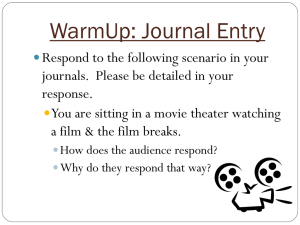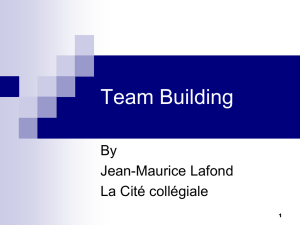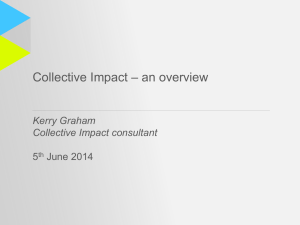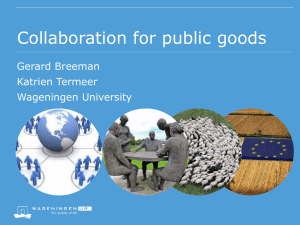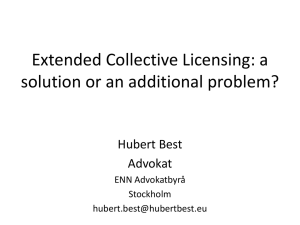Media studies- collective identiy version 2
advertisement
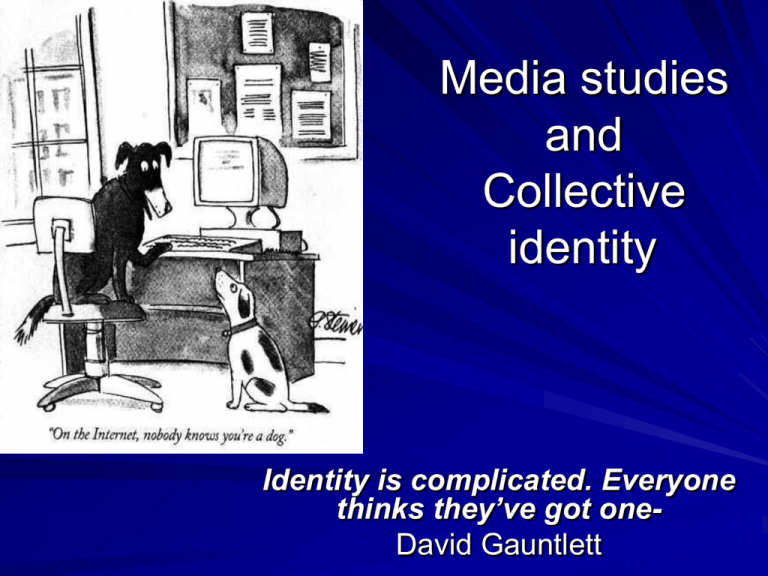
Media studies and Collective identity Identity is complicated. Everyone thinks they’ve got oneDavid Gauntlett Learning objectives L.O- To understand what is meant by the term Collective identity. To understand some ways in which identity is created in the modern world To understand the role the media had in creating identities Starter- What is identity and how do you create your own identity? The concept of a collective identity refers to a set of individuals' sense of belonging to the group or collective. For the individual, the identity derived from the collective shapes a part of his or her personal identity. It is possible, at times, that this sense of belonging to a particular group will be so strong that it will trump other aspects of the person's personal identity. To put it another way, Collective Identity is the idea that through participating in social activities, individuals can gain a sense of belonging and in essence an "identity" that transcends the individual. Therein are the rewards and risks of Social Networking. One can derive great satisfaction and sometimes great risks from participating. Within a typical collective, agreement is often valued over debate, though even more often fierce battles may erupt. How do you create your identity? Family Friends Fashion TV /film Social networking sites Magazines How do these videos create a collective identity of Britain? Compare these two as representational texts and discuss what we can conclude about changes in Britain. Compare these two as representational texts and discuss what we can conclude about changes in Britain. http://www.youtube.com/watch?v=Lqn5AIdd-9k http://www.youtube.com/watch?v=ltPxz4PinDA http://www.youtube.com/watch?v=LA04vzf9 Pmc Examples of collective identity Wikipedia- the power of collective thought Identities in social networking sites and virtual worlds Face book Second life World of war craft You tube fandom What else? The exam The specification asks for students to choose a specific topic area to be studied through specific case studies, texts, debates, and research. To cover at least two media and a range of texts, industries, audiences and debates Candidates must be prepared to answer an exam question related to one or more of the following prompts: How do the contemporary media represent nations, regions and ethnic/ social/collective groups of people in different ways? How does contemporary representation compare to previous time periods? What are the social implications of different media representations of groups of people? To what extent is human identity increasingly ‘mediated’? The questions:50 marks 1 hour Discuss the contemporary representation of a nation, religion or social group in the media using specific examples from at least two media to support your answer How far does the representation of a particular social group change over time? Refer to at least two media in your answer? Question one will usually discuss: to what extent/ how far/ have an opinion or take a view Question two will usually discuss: explain how something operates/ explain/respond to a quote or a statement. Key points to consider: How media that are in public circulation now represent groups of people in different ways How these representations can be seen as different to historical representations of the same groups The effects in society of different kinds of media representation of collective identities Ways in which people might use the media actively to form a collective identity Debates around the idea that our identities are increasingly constructed by, through or in response to the media (and arguments against this notion) Your answer Must include: One historical reference Contemporary references (last 5 years counts as contemporary) One future speculation in regards to your topic You must also mention the second media at least once. You can do the two media 90%/ 10% It is best to start your answer with: I am going to be discussing….i will be discussing this in reference to….. State why you are using it. Show awareness of both sides of the argument How media that are public circulation now represent groups of people in different ways How and which media present teenagers in a certain way? How do people who belong to a group on face book represent themselves? how are different cultures and religions represented? http://www.youtube.com/watch?v=8yIvxp0kt9I&feature=r elated Fans using Eastenders to create an identity http://www.youtube.com/watch?v=U5ABh7FJeWk&featur e=related Ways in which people might use the media actively to form a collective identity Second life (see article) You tube-Constructed Identity by the Collective: http://www.youtube.com/user/lonelygirl15?blend=1&ob=4 http://www.youtube.com/watch?v=bgOtnLmJxno&feature=topvideos Through YouTube activities like subscribing, ‘favoriting,’ rating, etc. (marketing and hype) Through YouTube direct feedback (user comments and video response) Through rejection of behaviors that do not comply with the identity as constructed by the collective Through YouTube direct feedback (user comments and video response) – “you’re such a classy lady, you’re bringing old hollywood glam back!” – “I JUST LOVE YOUR VOICE! When you talk... it's like Ingrid Bergman and Audrey Hepburn and Faye Dunaway all mixed together! You have the intonation down and everything. And your choice of words is fabulous!!” – “i friggin' LOVE YOU! I see so much Marilyn Monroe in you....you have no idea. And the cabaret thing....oh deary lord, Sally Bowles! ha.” --- “Marilyn was a construct...this gal is the real thing...cannot compare the two...thank you maryann for being who you are!” – “I wish you were my life coach....or my girlfriend.…” Through YouTube direct feedback (user comments and video response) – She started singing -> People start subscribing and commenting: response and expectations -> She reconstructs herself – ysabellabrave - as character only existing in expectations of her viewers, the negotiation between the individual and the collective – Clips: Blue Heaven, A Word or Two 02:36, Everyday Bravery http://www.youtube.com/watch?v=1hPpbUCEZzg Constructed Identity by the Collective Through rejection of behaviors that do not comply with the identity as constructed by the collective – Art videos - Videos provoked furious debate “This is no good. I mean you should stick to just singing only. This is way out of there. bizarre to say the least.” “A picture tells a thousand words: Twenty-four(!) pictures of yourself was simply way over the top for me…I am truly a fan of yours and watch your videos everyday. Would you please explain - so that I will find this less disturbing?” Constructed Identity by the Collective The "truthiness" problem – “Truthiness is the very definition of truth, 2006-style: ‘the quality of preferring concepts or facts one wishes to be true, rather than concepts or facts known to be true.’” – (excerpted from “Commentary: The Year in Pop Culture: 2006” in The Atlanta Journal-Constitution) Key points to consider YouTube is a testament to the participatory value of new media, folk cultures of digital age. Further inquiries: – What are implications of this fact that there is no authenticity? (peer-to-peer implies friendship and connectivity) – What do we lose when we acknowledge collectively constructed identities? – Is celebrating democracy enough? – Are other spaces more appropriate for interactions between individuals? – What happens when “truthiness” prevails over truth? What is the collective identity of the nuts reader? Breakfast cereal Car Holiday destination Fast food Furniture TV show Music Pet Media 2.0, mash-ups and reception theory "The Internet is a reflection of our society and that mirror is going to be reflecting what we see. If we do not like what we see in that mirror the problem is not to fix the mirror, we have to fix society." Vint Cerf, Google, 2004 Second life Second life Academic response to SL Anonymity Identity Masquerade Performance The networked self Community Role Motivation Complex interplay of ‘virtual’ and ‘real’ Virtual worlds Is Virtual Reality a new medium? How can we define immersion and simulation? Is immersive experience becoming the dominant paradigm for media? Is it the social distribution of media in VR that distinguishes it from film, for example? Is a virtual world a ‘distributed network’ of identities? How can we compare Second Life, World of Warcraft and GTA4 using these concepts?



